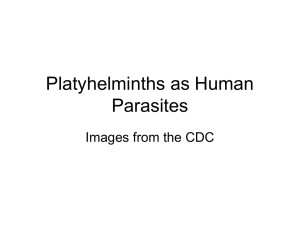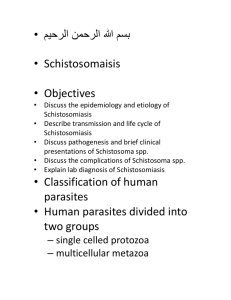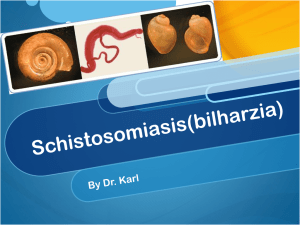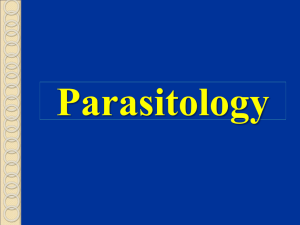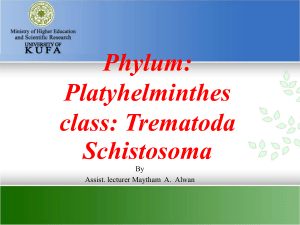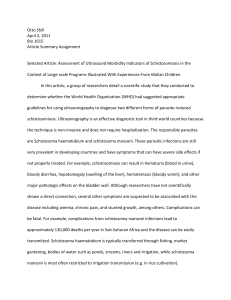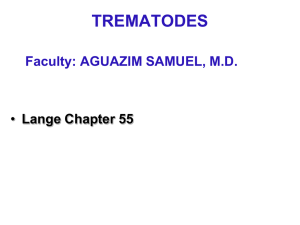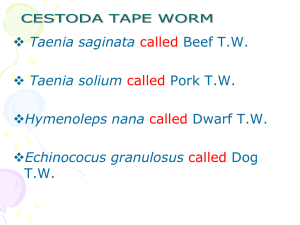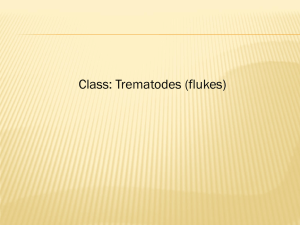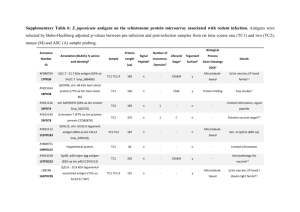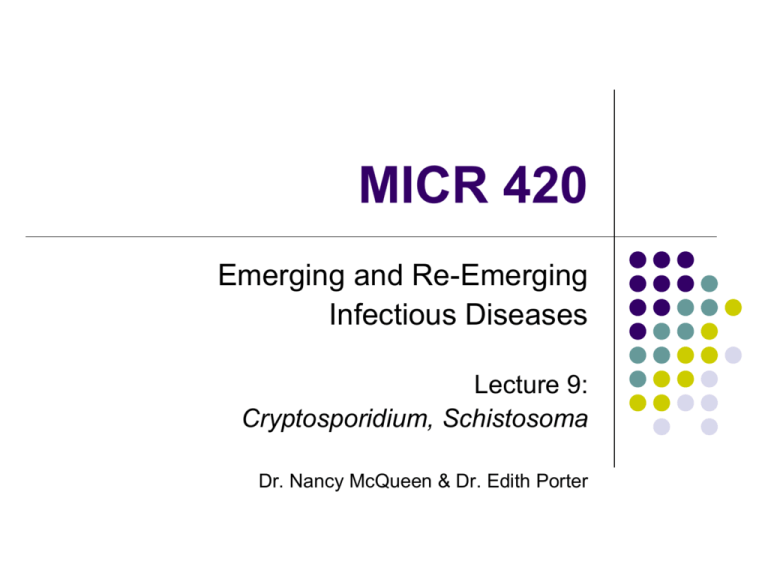
MICR 420
Emerging and Re-Emerging
Infectious Diseases
Lecture 9:
Cryptosporidium, Schistosoma
Dr. Nancy McQueen & Dr. Edith Porter
Cryptosporidium
Cryptosporidium
Protozoa
Currently 20 species
recognized
Reservoir
Apicomplexa
Sporozoa
Water
Oocysts
Sporozoites
Mammals, birds, reptiles
Waterborne infection
Affects primarily
intestinal tract
Invade intestinal epithelial cell
Life Cycle of Cryptosporidium
http://www.dpd.cdc.gov/dpdx/HTML/Cryptosporidiosis.htm
Cryptosporidiosis:
Pathogenesis
Formation of a unique intracellular
compartment in the apical region of the
host cell
Involves rearrangement of the host cell
cytoskeleton in intestinal epithelial cell
Incorporates host cell actin and alphaactinin into a host-parasite junctional
complex
Cryptosporidiosis: Disease
Infectious dose ~ 10 oocysts
Autoinfection
Incubation time 2 – 10 days
Massive diarrhea
Malnourished children and immunocompromised
Up to 25 bowel movements
Millions of oocysts are shed
Up to 17 liters fluid loss/day
Accompanied by fever
Last about for 1-2 weeks
Life threatening for immunocomprised patients
Some may not develop symptoms
Genetic association with certain MHC II types
Cryptosporidiosis: Diagnosis
Modified acid fast stain from
stool sample (Kinyoun)
ELISA testing for
Cryptosporidium antigen in stool
samples
IFA
Molecular (PCR)
5 mm
http://www.stanford.edu/class/humbio103/ParaSites2006/C
ryptosporidiosis/Images/acid-fast%20crypto%20(2).jpg
60-kDa glycoprotein gene (gp60)
http://www.dpd.cdc.gov/dpdx/HTML/Cryptosporidiosis.htm
Cryptosporidiosis: Therapy
Nitazoxanide in otherwise healthy patients
Nitrothiazole benzamide
Blocks anaerobic metabolism
Inhibition of the ferredoxine reductase
Is effective if immune system is functional
Also used in worm infections, some anaerobic
bacterial infections
Symptomatic
Improve immune system
Anti-retroviral therapy for AIDS patients
Cryptosporidiosis: Prevention
Problem: resistance to common disinfectants
Requires special water treatment in municipal
systems
Routine chlorine does not inactivate oocysts
Small size allows penetration through routine filter
Home filtration
Reverse osmosis
1 micron filters
Threats by Cryptosporidium
1993 Milwaukee outbreak
Contamination of the municipal water system
C. parvum
100 deaths and 400,000 illnesses
Critical Biological Agent for Public Health
Preparedness
Category B
Some potential for large-scale dissemination, but generally
cause less-severe illness than those in Category A
Could be used to contaminate food or water sources, and
many of them are relatively easy to obtain.
Difficult to detect, high dose in fecal movements and
low infectious dose
The worms crawls in,
the worms crawl out,
in your belly,
and out your snout.
ANONYMOUS
Overview
Schistosoma
Helminths
Morphology
Life cycles
Vector
Pathogenesis
Diseases
Diagnosis
Therapy
Prevention
Threats
Helminths: Classification
Animalia
Multicellular
Organs and biological
systems*
Circulatory
Nervous
Reproductive
Hermaphrodites
Dioecious
Digestive
Excretory
Phylum:
Platyhelminthes
(flatworms)
Class: Cestodes
(tapeworms)
Class: Trematodes
(flukes)
E.g., Schistosoma
Phylum: Nematodes
(roundworms)
E.g., Filaria
* Depending on species some systems may be lacking or rudimentary
Trematodes
Flukes
Oral sucker: food uptake
Incomplete digestive tract
Ventral Sucker: Attachment
Mostly hermaphroditic
(monoecious)
"Copyright Dennis Kunkel Microscopy, Inc.
(www.denniskunkel.com)"
Schistosoma
Schistosoma japonicum
Schistosoma mansoni
Schistosoma haematobium
Adults
Females size 7 to 20 mm
Males slightly smaller
Schistosoma: Life Cycle (1)
Infection from contaminated fresh
water in which certain types of
snails that carry schistosomes are
living
Schistosoma can penetrate the
skin
Within several weeks, worms grow
inside the blood vessels of the
body and produce eggs.
Some of these eggs travel to the
bladder or intestines and are
passed in the urine or stool
Schistosoma eggs gain access to
fresh water when infected people
urinate or defecate in the water.
Cercariae
Sporocysts
Adults
Miracidia
Eggs
Schistosoma: Life Cycle (2)
Developmental Stages of
Schistosoma
Egg
Cercaria
penetrating skin
Miracidia
Adult male and female
worms
Borowski et al. 2008, Trends in Parasitology Vol.24 No.11
The Apical Complex (ac) of
Cryptosporidia
Secretory organelles
multiple micronemes (mn)
single rhoptry (r)
Parasitrophus vacuole
formation
dense granules (dg)
Selection of host cells
Gliding motility
Modification of host cell
Zoite pellicle (p)
Cryptosporidium receptors
involved in host-cell
invasion
Borowski et al. 2008, Trends in Parasitology Vol.24 No.11
Sporozoites of C. parvum have to penetrate
intestinal mucus to establish host-cell
contact
(a)
(b)
(c)
(d)
Ingested oocysts adhere to ileal mucus via surface lectins.
Oocysts excyst and release four sporozoites.
Sporozoites express mucin-like surface receptors, which mediate attachment to the ileal mucus lining.
Sporozoites discharge enzymes to degrade intestinal mucus. The penetration of mucus is thus
facilitated.
(e) Sporozoites penetrate the mucus lining and establish host-cell contact via specific receptor–ligand
interactions.
Borowski et al. 2008, Trends in Parasitology Vol.24 No.11
Schistosoma and Affected
Organs
S. japonicum
superior mesenteric veins
of small intestine
S. mansoni
superior mesenteric veins
draining of large intestine
S. haematobium
venous plexus of bladder
Schistosoma: Virulence
Factors
Tegument
Soluble hypersensitivity antigen released by miracidia
within the eggs.
Unique double membrane structure
dynamic host-interactive layer involved in nutrition, immune
evasion and modulation, excretion, osmoregulation, sensory
reception and signal transduction
single syncytium that covers the entire body
Local inflammation
Glycan rich surface
Antioxidant enzymes
S. mansoni eggs in liver
Elastase-like IgE protease
Excretory/secretory (ES) molecules from cercariae
down-regulate the host's immune response
Bind host defense molecules on their surface
Schistosoma: Diseases
Bilharzia
Often asymptomatic
Acute schistosomiasis (Katayama's fever)
May occur weeks after the initial infection
S. mansoni and S. japonicum
Fever, cough, abdominal pain, diarrhea, hepatospenomegaly, and
eosinophilia
Occasionally central nervous system lesions occur
granulomatous lesions around ectopic eggs
Brain, spinal cord
Chronic infection
Granulomatous reactions and fibrosis in the affected organs
Colonic polyposis with bloody diarrhea (Schistosoma mansoni mostly)
Portal hypertension with hematemesis and splenomegaly (S. mansoni, S.
japonicum)
Cystitis and ureteritis (S. haematobium) with hematuria, which can progress
to bladder cancer;
Schistosoma and Cancer
General:
Chronic inflammation with chronic phagocytes at the
inflammatory site
Release reactive oxygen radicals and reactive nitrogen
radicals
Chronic inflammation leads to repeated cycles of cell
damage and compensatory cell proliferation
Promoting neoplasia
Schistosoma specific
Adult schistosomes liberate carcinogenic amines in urine
Increased beta-glucuronidase levels originating from
miracidia enclosed in the eggs
Khurana S et al. (2005) Indian J Med Microbiol. 2005 Apr;23(2):74-9.
Squamous Bladder Cancer
Induced by Schistosoma
Normal epithelium
Squamous bladder cancer
Schistosoma: Diagnosis
Microscopy
Antibody detection
ELISA and immunoblot
Schistosomal adult microsomal antigen
indicative only of schistosome infection at some
time
cannot be correlated with clinical status, worm
burden, egg production, or prognosis
Schistosoma: Identification of
Eggs
Spine
S. mansoni
S. japonicum
In Feces
S. haematobium
In Urine
Schistosoma: Therapy
Praziquantel for all species
Schistosoma: Prevention
No vaccine
Avoid wading, swimming or other fresh-water
contact in endemic countries
Avoid untreated piped water coming directly from
canals, lakes, rivers, streams or springs that may
contain cercariae
Heating bathing water to 50°C (122°F) for 5 minutes
or filtering water with fine-mesh filters
Allow bathing water to stand for 2 days because
cercariae rarely remain infective longer than 24 h
Schistosoma: Epidemiology
200 million people infected world wide in over 70
countries
50% endemic among the local population in high
infested areas
South America
Caribbean
Africa
Middle East
Far East
Depends on species
Schistosoma: Endemic Areas
Threats by Schistosoma
Mainly threat to population in endemic areas
and to travelers
Resistance against praziquantel
Resources
The Microbial Challenge, by Krasner, ASM Press, Washington DC, 2002.
Brock Biology of Microorganisms, by Madigan and Martinko, Pearson Prentice Hall,
Upper Saddle River, NJ, 11th ed, 2006.
Microbiology: An Introduction, by Tortora, Funke and Case; Pearson Prentice Hall;
9th ed, 2007.
www.asnom.org/.../nodule_oncho.jpg
http://www.icp.ucl.ac.be/~opperd/parasites/images/man.jpg
http://www.the-travel-doctor.com/filari9.gif
http://www.payer.de/entwicklung/entw2029.gif
http://emu.arsusda.gov/typesof/images/onchyo.jpg
http://www.denniskunkel.com/product_info.php?products_id=1089
http://www.denniskunkel.com/product_info.php?products_id=592
http://www.cdc.gov/ncidod/dpd/parasites/schistosomiasis/default.htm
http://www2.ncid.cdc.gov/travel/yb/utils/ybGet.asp?section=dis&obj=schisto.htm
http://education.vetmed.vt.edu/curriculum/VM8054/Labs/Lab4/IMAGES/SIMPL%20C
OLM%202%20GALL.JPG
http://www.pathguy.com/lectures/bladder_cis.jpg
http://www.dpd.cdc.gov/dpdx/HTML/ImageLibrary/Schistosomiasis_il.htm
Bayne 2009, Molecular & Biochemical Parasitology 165 (2009) 8–18

